Synthesis and Antifungal Activity of Coumarin Derivatives Containing Hydrazone Moiety
Abstract
Plant disease control mainly relies on pesticides. In this study, a series of coumarin derivatives containing hydrazone moiety were designed and synthesized. The synthesized compounds were characterized and used to evaluate the antifungal activity against four pathogens, Botrytis cinerea, Alternaria solani, Fusarium oxysporum, and Alternaria alternata. The results showed that the inhibition rate of some compounds at 100 μg/mL in 96 hours reached around 70 % against A. alternata, higher than that of the positive control. The corresponding EC50 values were found at around 30 μg/mL. Finally, the compound 3 b was screened out with the lowest EC50 value (19.49 μg/mL). The analysis of SEM and TEM confirmed that the compound 3 b can obviously damage the morphological structure of hyphae, resulting in the depletion of the cells by the destruction of morphological matrix and leakage of contents. RNA sequencing showed that compounds 3 b mainly affected the pentose phosphate pathway, which caused to destroy the layer of mitochondrial structure. Molecular docking showed that compounds 3 b fitted the binding pocket of yeast transketolase and interacted with lysine at the hydrazone structure. Our results suggested that the introduction of hydrazone was an effective strategy for the design of novel bioactive compounds.
Graphical Abstract
Conflict of interests
The authors declare no conflict of interest.
Open Research
Data Availability Statement
The data that support the findings of this study are available from the corresponding author upon reasonable request.





